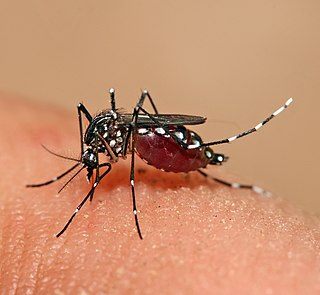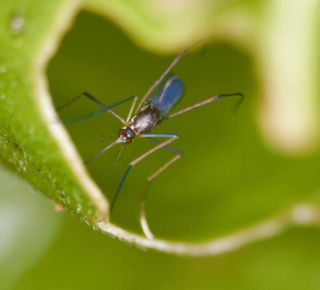Species
Subgenus (Abraedes) Zavortink, 1970
- Aedes papago Zavortink, 1970
Subgenus (Acartomyia) Theobald, 1903
- Aedes mariae (Sergent and Sergent, 1903)
- Aedes phoeniciae (Coluzzi and Sabatini, 1968)
- Aedes zammitii (Theobald, 1903)
Subgenus (Aedes) Meigen, 1818
- Aedes alexandre Gornostaeva 2005
- Aedes cinereus Meigen, 1818
- Aedes dahuricus Danilov, 1987
- Aedes dmitryi Gornostaeva, 2005
- Aedes esoensis Yamada, 1921
- Aedes geminus Peus, 1970
- Aedes mubiensis Luh and Shih, 1958
- Aedes nataliae Gornostaeva, 2005
- Aedes rossicus Dolbeskin, Gorichaja and Mitrofanova, 1930
- Aedes sasai Tanaka, Mizusawa and Saugstad, 1975
- Aedes valeryi Gornostaeva, 2005
- Aedes yamadai Sasa, Kano and Takahashi, 1950
- Aedes perditus (Leicester, 1908)
Subgenus (Aedimorphus) Theobald, 1903
- Aedes abnormalis (Theobald, 1909)
- Aedes abnormalis abnormalis(Theobald, 1909)
- Aedes abnormalis kabwachensisEdwards, 1941
- Aedes aerarius McIntosh, 1975
- Aedes albodorsalis Fontenille and Brunhes, 1985
- Aedes alboscutellatus (Theobald, 1905)
- Aedes alboventralis (Theobald, 1910)
- Aedes argenteoscutellatus Carter and Wijesundara, 1948
- Aedes bambiotai Geoffroy, 1987
- Aedes bancoi Geoffroy, 1987
- Aedes bevisi Edwards, 1915)
- Aedes caecus (Theobald, 1901)
- Aedes caliginosus (Graham, 1910)
- Aedes centropunctatus (Theobald, 1913)
- Aedes culicinus Edwards, 1922
- Aedes cumminsii (Theobald, 1903)
- Aedes cumminsii cumminsii(Theobald, 1903)
- Aedes cumminsii mesosticusHarbach, 2018
- Aedes dalzieli (Theobald, 1910)
- Aedes davidi Basio, 1971
- Aedes dentatus (Theobald, 1904)
- Aedes domesticus (Theobald, 1901)
- Aedes durbanensis Theobald, 1903)
- Aedes durbanensis angolaeRibeiro and da Cunha Ramos, 1974
- Aedes durbanensis durbanensisTheobald, 1903
- Aedes ebogoensis Rickenbach and Ferrara, 1965
- Aedes eritreae Lewis, 1942
- Aedes fowleri (de Charmoy, 1908)
- Aedes gibbinsi Edwards, 1935
- Aedes gouldi Reinert, 1972
- Aedes hirsutus (Theobald, 1901)
- Aedes hirsutus adenensisEdwards, 1941
- Aedes hirsutus hirsutusTheobald, 1901
- Aedes holocinctus Edwards, 1941
- Aedes jamesi Edwards, 1914)
- Aedes karooensis Muspratt, 1961
- Aedes leesoni Edwards, 1932
- Aedes leptolabis Edwards, 1936
- Aedes leucarthrius (Speiser, 1909)
- Aedes longiseta Edwards, 1936
- Aedes lowisii (Theobald, 1910)
- Aedes mansouri Qutubuddin, 1959
- Aedes masoalensis Fontenille and Brunhes, 1985
- Aedes mathioti Fontenille and Brunhes, 1985
- Aedes mattinglyi Hamon and Rickenbach, 1954
- Aedes mediolineatus (Theobald,1901)
- Aedes natronius Edwards, 1932
- Aedes nigricephalus (Theobald, 1901)
- Aedes nigrostriatus (Barraud, 1927)
- Aedes oakleyi Stone, 1939
- Aedes ochraceus (Theobald, 1901)
- Aedes orbitae Edwards, 1922
- Aedes ovazzai Hamon and Adam, 1959
- Aedes pachyurus Edwards, 1936
- Aedes pallidostriatus (Theobald, 1907)
- Aedes pampangensis (Ludlow, 1905)
- Aedes pipersalatus (Giles, 1902)
- Aedes pubescens Edwards, 1925
- Aedes punctifemoris (Ludlow, 1921)
- Aedes quasiunivittatus (Theobald, 1901)
- Aedes rickenbachi Hamon and Adam, 1959
- Aedes semlikiensis van Someren, 1950
- Aedes senyavinensis Knight and Hurlbut, 1949
- Aedes stenoetrus (Theobald, 1907)
- Aedes subdentatus Edwards, 1936
- Aedes syntheticus Barraud, 1928
- Aedes taeniorhynchoides (Christophers, 1911)
- Aedes tauffliebi Rickenbach and Ferrara, 1965
- Aedes tricholabis Edwards, 1941
- Aedes tricholabis bwambavan Someren, 1950
- Aedes tricholabis tricholabisEdwards, 1941
- Aedes trimaculatus (Theobald,1905)
- Aedes trukensis Bohart, 1957
- Aedes vexans (Meigen, 1830) –vexans mosquito
- Aedes vexans arabiensisPatton, 1905
- Aedes vexans nipponiiTheobald, 1907
- Aedes vexans nocturnusTheobald, 1903
- Aedes vexans vexansMeigen, 1830
- Aedes wigglesworthi Edwards ,1941
- Aedes suzannae Boussès, 2022
Subgenus (Alanstonea) Mattingly, 1960
- Aedes brevitibia (Edwards, 1914)
- Aedes treubi (de Meijere, 1910)
Subgenus (Albuginosus) Reinert, 1987
- Aedes capensis Edwards, 1924
- Aedes gilliesi van Someren, 1962
- Aedes haworthi Edwards, 1923
- Aedes kapretwae Edwards, 1941
- Aedes kennethi Muspratt, 1956
- Aedes marshallii (Theobald, 1901)
- Aedes ngong van Someren, 1950
- Aedes stokesi Evans, 1929
- Aedes teesdalei van Someren, 1954
Subgenus (Ayurakitia) Thurman, 1954
- Aedes griffithi (Thurman, 1954)
- Aedes peytoni Reinert, 1972
Subgenus (Aztecaedes) Zavortink, 1972
- Aedes ramirezi Vargas and Downs, 1950
Subgenus (Belkinius) Reinert, 1982
- Aedes aurotaeniatus Edwards, 1922
Subgenus (Bifidistylus) Reinert, Harbach and Kitching, 2009
- Aedes boneti Gil Collado,1936
- Aedes boneti bonetiGil Collado, 1936
- Aedes boneti kumbaeChwatt, 1948
- Aedes lamborni Edwards,1923
Subgenus (Borichinda) Harbach and Rattanarithikul, 2007
- Aedes cavernicola (Rattanarithikul and Harbach, 2007)
Subgenus (Bothaella) Reinert, 1973
- Aedes alongi Galliard and Ngu, 1947
- Aedes brownscutumus X. Dong, Zhou and L. Dong, 1999
- Aedes eldridgei Reinert, 1973
- Aedes helenae Reinert, 1973
- Aedes kleini Reinert, 1973
- Aedes manhi (Harbach and Cook, 2010)
Subgenus (Bruceharrisonius) Reinert, 2003
- Aedes alektorovi Stackelberg, 1943
- Aedes aureostriatus (Doleschall, 1857)
- Aedes christophersi Edwards, 1922
- Aedes dooni Wattal, Bhatia and Kalra, 1958
- Aedes greeni (Theobald, 1903)
- Aedes hurlbuti Lien, 1967
- Aedes kobayashii Nakata, 1956
- Aedes okinawanus Bohart, 1946
- Aedes taiwanus Lien, 1968
Subgenus (Cancraedes) Edwards, 1929
- Aedes cancricomes Edwards, 1922
- Aedes curtipes Edwards, 1915
- Aedes indonesiae Mattingly, 1958
- Aedes kohkutensis Mattingly, 1958
- Aedes mamoedjoensis Mattingly, 1958
- Aedes masculinus Mattingly, 1958
- Aedes palawanicus Mattingly, 1958
- Aedes penghuensis Lien, 1968
- Aedes simplex (Theobald, 1903)
- Aedes thurmanae Mattingly, 1958
Subgenus (Catageomyia) Theobald, 1903
- Aedes adami Geoffroy, 1971
- Aedes argenteopunctatus (Theobald, 1901
- Aedes bedfordi Edwards,1936
- Aedes chamboni Cornet, 1968
- Aedes dialloi Hamon and Brengues, 1965
- Aedes falabreguesi Hamon, 1957
- Aedes filicis Ingram and De Meillon, 1927
- Aedes grenieri Hamon, Service, Adam and Taufflieb, 1961
- Aedes hopkinsi Edwards, 1936
- Aedes insolens Edwards, 1936
- Aedes irritans (Theobald, 1901
- Aedes lokojensis Service, 1959
- Aedes lottei Hamon and Brengues, 1965
- Aedes microstictus Edwards, 1936
- Aedes minutus (Theobald, 1901
- Aedes mixtus Edwards, 1936
- Aedes mutilus Edwards, 1936
- Aedes nyounae Hamon and Adam, 1959
- Aedes phyllolabis Edwards, 1929
- Aedes pseudotarsalis van Someren, 1946
- Aedes puntothoracis (Theobald, 1909
- Aedes reali Hamon and Adam, 1959
- Aedes smithburni van Someren, 1950
- Aedes stenoscutus Edwards, 1912
- Aedes tarsalis (Newstead, 1907
- Aedes veeniae McIntosh, 1975
- Aedes wendyae Service, 1959
- Aedes yangambiensis De Meillon and Lavoipierre, 1944
- Aedes yvonneae Edwards, 1941
Subgenus (Catatassomyia) Dyar and Shannon, 1925
- Aedes meronephada (Dyar and Shannon, 1925)
Subgenus (Christophersiomyia) Barraud, 1923
- Aedes annulirostris (Theobald, 1905)
- Aedes chionodes Belkin, 1962
- Aedes gombakensis Mattingly, 1959
- Aedes ibis Barraud, 1931
- Aedes thomsoni (Theobald, 1905)
Subgenus (Coetzeemyia) Huang, Mathis and Wilkerson, 2010
- Aedes fryeri (Theobald, 1912)
Subgenus (Collessius) Reinert, Harbach and Kitching, 2006
- Aedes banksi Edwards, 1922
- Aedes elsiae (Barraud, 1923)
- Aedes hatorii Yamada, 1921
- Aedes macdougalli Edwards, 1922
- Aedes macfarlanei (Edwards, 1914)
- Aedes ningheensis Lei, 1989
- Aedes pseudotaeniatus (Giles, 1901)
- Aedes shortii (Barraud, 1923)
- Aedes tonkinensis Galliard and Ngu, 1947
Subgenus (Cornetius) Huang, 2005
- Aedes cozi Cornet, 1973
Subgenus (Dahliana) Reinert, Harbach and Kitching, 2006
- Aedes echinus (Edwards, 1920)
- Aedes geniculatus (Olivier, 1791) – tree hole mosquito
- Aedes gilcolladoi (Sánchez-Covisa, Rodríguez Rodríguez and Guillén Llera, 1985)
Subgenus (Danielsia) Theobald, 1904
- Aedes albotaeniatus (Leicester, 1904)
- Aedes harperi Knight, 1948
- Aedes lepchanus (Barraud, 1923)
Subgenus (Dendroskusea) Edwards, 1929
- Aedes kanarensis Edwards, 1934
- Aedes micropterus (Giles, 1901)
- Aedes periskelatus (Giles, 1902)
- Aedes bramachandrai Reuben, 1967
- Aedes reginae Edwards, 1922
Subgenus (Diceromyia) Theobald, 1911
- Aedes adersi (Edwards, 1917)
- Aedes bananea (Wolfs, 1958)
- Aedes cordellieri Huang, 1986
- Aedes fascipalpis (Edwards, 1912)
- Aedes flavicollis Edwards, 1928
- Aedes furcifer (Edwards, 1913)
- Aedes mefouensis Ferrara, 1974
- Aedes taylori (Edwards, 1936)
Subgenus (Dobrotworkyius) Reinert, Harbach and Kitching, 2006
- Aedes alboannulatus (Macquart, 1850)

- Aedes milsoni (Taylor, 1915)
- Aedes occidentalis (Skuse, 1889)
- Aedes rubrithorax (Macquart, 1850)
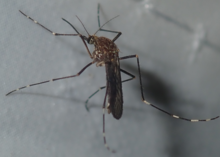
- Aedes rupestris Dobrotworsky, 1959
- Aedes subbasalis Dobrotworsky, 1962
- Aedes tubbutiensis Dobrotworsky, 1959
Subgenus (Downsiomyia) Vargas, 1950
- Aedes albolateralis (Theobald, 1908)
- Aedes alboniveus Barraud, 1934
- Aedes axitiosus Kulasekera, Knight and Harbach, 1990
- Aedes dorseyi Knight, 1946
- Aedes ganapathi Colless, 1958
- Aedes harinasutai Knight, 1978
- Aedes idjenensis Brug, 1934
- Aedes inermis Colless, 1958
- Aedes lacteus Knight, 1946
- Aedes laoagensis Knight, 1946
- Aedes leonis Colless, 1958
- Aedes litoreus Colless, 1958
- Aedes mikrokopion Knight and Harrison, 1988
- Aedes mjobergi (Edwards, 1926)
- Aedes mohani Knight, 1969
- Aedes nipponicus La Casse and Yam
- Aedes omorii Lien, 1968
Subgenus (Edwardsaedes) Belkin, 1962
- Aedes bekkui Mogi, 1977
- Aedes imprimens (Walker, 1860)
- Aedes pingpaensis Chang, 1965
Subgenus (Elpeytonius) Reinert, Harbach and Kitching, 2009
- Aedes apicoannulatus (Edwards, 1912)
- Aedes simulans (Newstead and Carter, 1911)
Subgenus (Finlaya) Theobald, 1903
- Aedes alocasicola Marks, 1947
- Aedes ananae Knight and Laffoon, 1946
- Aedes avistylus Brug, 1939
- Aedes bougainvillensis Marks, 1947
- Aedes burnetti Belkin, 1962
- Aedes croceus Knight and Laffoon, 1946
- Aedes dobrotworskyi Marks, 1958
- Aedes fijiensis Marks, 1947
- Aedes flavipennis (Giles, 1904)
- Aedes franclemonti Belkin, 1962
- Aedes freycinetiae Laird, 1957
- Aedes fuscipalpis Belkin, 1962
- Aedes fuscitarsis Belkin, 1962
- Aedes gahnicola Marks, 1947
- Aedes gani Bonne- Wepster, 1940
- Aedes gressitti Bohart, 1957
- Aedes hollingsheadi Belkin, 1962
- Aedes horotoi Taylor, 1972
- Aedes hui Bohart, 1957
- Aedes josephinae Marks, 1958
- Aedes knighti Stone and Bohart, 1944
- Aedes kochi (Dönitz, 1901)
- Aedes lewelleni Starkey and Webb, 1946
- Aedes luteus (Ludlow, 1905)
- Aedes maffii Taylor and Tenorio, 1974
- Aedes medleri Knight and Laffoon, 1946
- Aedes neogeorgianus Belkin, 1962
- Aedes oceanicus Belkin, 1962
- Aedes poicilius (Theobald, 1903)

- Aedes samoanus (Grünberg, 1913)
- Aedes schlosseri Belkin, 1962
- Aedes solomonis Stone and Bohart, 1944
- Aedes sorsogonensis Bañez and Jueco, 1966
- Aedes stonei Knight and Laffoon, 1946
- Aedes tutuilae Ramalingam and Belkin, 1965
- Aedes wallacei Edwards, 1926
Subgenus (Fredwardsius) Reinert, 2000
- Aedes vittatus (Bigot, 1861)
Subgenus (Georgecraigius) Reinert, Harbach and Kitching, 2006
- Aedes atropalpus (Coquillett, 1902)
- Aedes epactius (Dyar and Knab, 1908)
- Aedes fluviatilis (Lutz in Bourroul, 1904)
Subgenus (Geoskusea) Edwards, 1929
- Aedes baisasi Knight and Hull, 1951
- Aedes becki Belkin, 1962
- Aedes daggyi Stone and Bohart, 1944
- Aedes fimbripes Edwards, 1924
- Aedes kabaenensis Brug, 1939
- Aedes longiforceps Edwards, 1929
- Aedes lunulatus King and Hoogstraal, 1946
- Aedes perryi Belkin, 1962
- Aedes timorensis (Miyagi, Toma and Lien, 2004)
- Aedes tonsus Edwards, 1924
Subgenus (Gilesius) Reinert, Harbach and Kitching, 2006
- Aedes alius Lien, 1968
- Aedes pulchriventer (Giles, 1901)
Subgenus (Gymnometopa) Coquillett, 1906
- Aedes mediovittatus Coquillett, 1906)
Subgenus (Halaedes) Belkin, 1962
- Aedes ashworthi (Erichson, 1842)
- Aedes australis Edwards, 1921
- Aedes wardangensis Brust, Ballard, Driver, Hartley, Galway and Curran, 1998
Subgenus (Himalaius) Reinert, Harbach and Kitching, 2006
- Aedes gilli (Barraud, 1924)
- Aedes simlensis Edwards, 1922
Subgenus (Hopkinsius) Reinert, Harbach and Kitching, 2006
- Aedes albocinctus (Barraud, 1924)
- Aedes barnardi Edwards, 1924
- Aedes embuensis Edwards, 1930
- Aedes ingrami Edwards, 1930
- Aedes nyasae Edwards, 1930
- Aedes seoulensis Yamada, 1921
- Aedes wellmanii (Theobald, 1905)
Subgenus (Howardina) Theobald, 1903
- Aedes albonotatus (Coquillett, 1906)
- Aedes allotecnon Kumm, Komp and Ruiz, 1940
- Aedes arborealis BonneWepster and Bonne, 1920
- Aedes argyrites Dyar and Nuñez Tovar, 1927
- Aedes aureolineatus Berlin, 1969
- Aedes aurites (Theobald, 1907)
- Aedes aurivittatus Cerqueira, 1943
- Aedes bahamensis Berlin, 1969
- Aedes brevis Berlin, 1969
- Aedesnbrevivittatus Berlin, 1969
- Aedes busckii (Coquillett, 1906)
- Aedes cozumelensis Díaz Nájera, 1966
- Aedes ecuadoriensis Berlin, 1969
- Aedes eleanorae Berlin, 1969
- Aedes fulvithorax (Lutz, 1904)
- Aedes grabhami (Berlin, 1969)
- Aedes guatemala Berlin, 1969
- Aedes guerrero Berlin, 1969
- Aedes inaequalis (Grabham, 1907)
- Aedes ioliota Dyar and Knab, 1913
- Aedes leei Berlin, 1969
- Aedes lorraineae Berlin, 1969
- Aedes marinkellei Berlin, 1969
- Aedes martinezi Berlin, 1969
- Aedes osornoi Berlin, 1969
- Aedes pseudodominicii Komp, 1936
- Aedes quadrivittatus (Coquillett, 1902)
- Aedes septemstriatus Dyar and Knab, 1907
- Aedes sexlineatus (Theobald, 1901)
- Aedes spinosus Berlin, 1969
- Aedes stenei Thompson, 1956
- Aedes vanemdeni Martini, 1931
- Aedes walkeri (Theobald, 1901)
- Aedes whitmorei Dunn, 1918
Subgenus (Huaedes) Huang, 1968
- Aedes medialis (Brug, 1932)
- Aedes variepictus King and Hoogstraal, 1946
- Aedes wauensis Huang, 1968
Subgenus (Hulecoeteomyia) Theobald, 1904
- Aedes bhutanensis Somboon and Harbach, 2020
- Aedes cherrapunjensis (Natarajan, Rajavel and Jambulingam, 2016)
- Aedes chrysolineatus (Theobald, 1907)
- Aedes formosensis Yamada, 1921
- Aedes harveyi (Barraud, 1923)
- Aedes japonicus (Theobald, 1901) - Asian bush mosquito, Japanese bush mosquito
- Aedes japonicus amamiensisTanaka, Mizusawa and Saugstad, 1979
- Aedes japonicus japonicusTheobald, 1901
- Aedes japonicus shintienensisTsai and Lien, 1950
- Aedes japonicus yaeyamensisTanaka, Mizusawa and Saugstad, 1979
- Aedes jugraensis (Leicester, 1908)
- Aedes koreicus (Edwards, 1917) - Korean bush mosquito
- Aedes nigrorhynchus Brug, 1931
- Aedes pallirostris Edwards, 1922
- Aedes reinerti Rattanarithikul and Harrison, 1988
- Aedes rizali (Banks, 1906)
- Aedes saxicola (Edwards, 1922)
Subgenus (Indusius) Edwards in Barraud, 1934
- Aedes pulverulenus Edwards, 1922
Subgenus (Isoaedes) Reinert, 1979
- Aedes cavaticus Reinert, 1979
Subgenus (Jarnellius) Reinert, Harbach and Kitching, 2006
- Aedes deserticola Zavortink, 1970
- Aedes laguna Arnell and Nielsen, 1972
- Aedes monticola Belkin and McDonald, 1957
- Aedes sierrensis (Ludlow, 1905)-western treehole mosquito

- Aedes varipalpus (Coquillett, 1902)
Subgenus (Jihlienius) Reinert, Harbach and Kitching, 2006
- Aedes chungi Lien, 1968
- Aedes gonguoensis (Gong and Lu, 1986)
- Aedes unicinctus Edwards, 1922
Subgenus (Kenknightia) Reinert, 1990
- Aedes dissimilierodes (X. Dong, Zhou and L. Dong, 2002)
- Aedes dissimilis (Leicester, 1908)
- Aedes gaffigani Reinert, 1990
- Aedes harbachi Reinert, 1990
- Aedes karwari (Barraud, 1924)
- Aedes lerozeboomi Reinert, 1990
- Aedes leucomeres (Giles, 1904)
- Aedes litwakae Reinert, 1990
- Aedes luzonensis Rozeboom, 1946
- Aedes paradissimilis Rozeboom, 1946
- Aedes pecori Reinert, 1990
- Aedes wilkersoni Reinert, 1990
Subgenus (Kompia) Aitken, 1941
- Aedes purpureipes Aitken, 1941
Subgenus (Leptosomatomyia) Theobald, 1905
- Aedes aurimargo Edwards, 1922
Subgenus (Levua) Stone and Bohart, 1944
- Aedes geoskusea Amos, 1944
Subgenus (Lewnielsenius) Reinert, Harbach and Kitching, 2006
- Aedes muelleri Dyar, 1920
Subgenus (Lorrainea) Belkin, 1962
- Aedes amesii (Ludlow, 1903)
- Aedes celebicus Mattingly, 1959
- Aedes dasyorrhus King and Hoogstraal, 1946
- Aedes fumidus Edwards, 1928
- Aedes lamelliferus Bohart and Ingram, 1946
Subgenus (Luius) Reinert, Harbach and Kitching, 2008
- Aedes fengi (Edwards, 1935)
Subgenus (Macleaya) Theobald, 1903
- Aedes calabyi Marks, 1963
- Aedes elchoensis Taylor, 1929
- Aedes humeralis Edwards, 1922
- Aedes littlechildi Taylor, 1933
- Aedes macmillani Marks, 1964
- Aedes moloiensis Taylor, 1929
- Aedes spinosipes Edwards, 1922
- Aedes stoneorum Marks, 1977
- Aedes tremulus (Theobald, 1903)
- Aedes tulliae (Taylor, 1929)
- Aedes wattensismm Taylor, 1929
Subgenus (Molpemyia) Theobald, 1910
- Aedes auridorsum Edwards, 1922
- Aedes pecuniosus Edwards, 1922
- Aedes purpureus (Theobald, 1910)
Subgenus (Mucidus) Theobald, 1901
- Aedes alternans (Westwood, 1835)

- Aedes aurantius (Theobald, 1907)

- Aedes aurantius aurantius(Theobald, 1907)
- Aedes aurantius chrysogaster(Taylor, 1927)
- Aedes ferinus (Knight, 1947)
- Aedes grahamii (Theobald, 1909)
- Aedes laniger (Wiedemann, 1820)
- Aedes lucianus Muspratt, 1959
- Aedes mucidus (Karsch, 1887)
- Aedes nigerrimus (Theobald, 1913)
- Aedes nigrescens (Edwards in Paine and Edwards, 1929)
- Aedes quadripunctis (Ludlow, 1910)
- Aedes quasiferinus Mattingly, 1961
- Aedes scatophagoides (Theobald, 1901)
- Aedes sudanensis (Theobald, 1908)
- Aedes tonkingi Gebert, 1948
Subgenus (Neomelaniconion) Newstead, 1907
- Aedes albicosta (Edwards, 1913)
- Aedes albiradius (Le Goff, Boussès and Brunhes, 2007)
- Aedes albothorax (Theobald, 1907)
- Aedes aurovenatus Worth, 1960
- Aedes belleci (Le Goff, Boussès and Brunhes, 2007)
- Aedes bequaerti Wolfs, 1947
- Aedes bergerardi Pajot and Geoffroy, 1971
- Aedes bolense Edwards, 1936
- Aedes carteri Edwards, 1936
- Aedes circumluteolus (Theobald, 1908)
- Aedes crassiforceps Edwards, 1927
- Aedes ellinorae Edwards, 1941
- Aedes flavimargo Edwards, 1941
- Aedes fontenillei (Le Goff, Boussès and Brunhes, 2007)
- Aedes fuscinervis (Edwards, 1914)
- Aedes hylaius (Harbach, 2018)
- Aedes jamoti Hamon and Rickenbach, 1954
- Aedes lineatopennis (Ludlow, 1905)
- Aedes lineatopennis aureusGutsevich, 1955
- Aedes lineatopennis lineatopennisLudlow, 1905
- Aedes luridus McIntosh, 1971
- Aedes luteolateralis (Theobald, 1901)
- Aedes mcintoshi Huang, 1985
- Aedes monotrichus Edwards, 1936
- Aedes nigropterum (Le Goff, Boussès and Brunhes, 2007)
- Aedes palpalis (Newstead, 1907)
- Aedes pogonurus Edwards, 1936
- Aedes punctocostalis (Theobald, 1909)
- Aedes taeniarostris (Theobald, 1909
- Aedes unidentatus McIntosh, 1971
Subgenus (Nyctomyia) Harbach, 2013
- Aedes pholeocola (Harbach in Harbach and Taai, 2014)
- Aedes biunguiculatus (Linton and Harbach, 2013)
Subgenus (Ochlerotatus) Lynch Arribálzaga, 1891
- Aedes aboriginis Dyar, 1917-northwest coast mosquito
- Aedes abserratus (Felt and Young, 1904)
- Aedes aculeatus (Theobald, 1903)
- Aedes aenigmaticus Cerqueira and Costa, 1946
- Aedes akkeshiensis Tanaka, 1998
- Aedes albifasciatus (Macquart, 1838)

- Aedes albineus Séguy, 1923
- Aedes aloponotum Dyar, 1917
- Aedes amateuri Ortega and Zavortink in Ortega-Morales et al., 2019
- Aedes ambreensis Rodhain and Boutonnier, 1983
- Aedes andersoni Edwards, 1926
- Aedes angustivittatus Dyar and Knab, 1907
- Aedes annulipes (Meigen, 1830)
- Aedes antipodeus (Edwards, 1920)

- Aedes arundinariae Kasper, 2020
- Aedes atactavittatus Arnell, 1976
- Aedes atlanticus Dyar and Knab, 1906
- Aedes auratus Grabham, 1906
- Aedes aurifer (Coquillett, 1903)
- Aedes behningi Martini, 1926
- Aedes bejaranoi Martínez, Carcavallo and Prosen, 1960
- Aedes berlandi Séguy, 1921
- Aedes bimaculatus (Coquillett, 1902)
- Aedes biskraensis Brunhes, 1999
- Aedes bogotanus Arnell, 1976
- Aedes breedensis Muspratt, 1953
- Aedes burjaticus (Kuchartshuk, 1973)
- Aedes burpengaryensis (Theobald, 1905)
- Aedes caballus (Theobald, 1912)
- Aedes cacozelus Marks, 1963
- Aedes calcariae Marks, 1957
- Aedes calumnior Belkin, Heinemann and Page, 1970
- Aedes campestris Dyar and Knab, 1907
- Aedes camptorhynchus (Thomson, 1869)
- Aedes canadensis (Theobald, 1901) - woodland pool mosquito
- Aedes canadensis canadensis(Theobald, 1901)

- Aedes canadensis mathesoniMiddlekauff, 1944
- Aedes cantans (Meigen, 1818)

- Aedes cantator (Coquillett, 1903) - brown saltmarsh mosquito
- Aedes caspius (Pallas, 1771)

- Aedes caspius caspius(Pallas, 1771)

- Aedes caspius hargreavesiEdwards, 1920
- Aedes caspius meiraiRibeiro, Ramos, Capela and Pires, 1980
- Aedes cataphylla Dyar, 1916
- Aedes chelli (Edwards, 1915)
- Aedes churchillensis Ellisand Burst, 1973
- Aedes clelandi (Taylor, 1914)
- Aedes clivis Lanzaro and Eldridge, 1992
- Aedes coluzzii Rioux, Guilvard and Pasteur, 1998
- Aedes comitatus Arnell, 1976
- Aedes communis (de Geer, 1776)
- Aedes condolescens Dyar and Knab, 1907
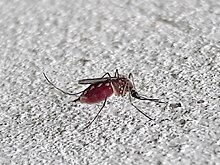
- Aedes continentalis Dobrotworsky, 1960
- Aedes crinifer (Theobald, 1903)
- Aedes cunabulanus Edwards, 1924
- Aedes cyprioides Danilov and Stupin, 1982
- Aedes cyprius Ludlow, 1920
- Aedes dahlae (Nielsen, 2009)
- Aedes decticus Howard, Dyar and Knab, 1917
- Aedes deficiens Arnell, 1976
- Aedes detritus Haliday, 1833
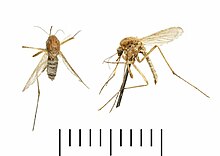
- Aedes diantaeus Howard, Dyar and Knab, 1913
- Aedes dorsalis (Meigen, 1830)
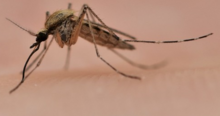
- Aedes dufouri Hamon, 1953
- Aedes duplex Martini, 1926
- Aedes dupreei (Coquillett, 1904)
- Aedes dzeta Séguy, 1924
- Aedes edgari Stone and Rosen, 1952
- Aedes eidsvoldensis Mackerras, 1927
- Aedes eucephalaeus Dyar, 1918
- Aedes euedes Howard, Dyar and Knab, 1913
- Aedes euiris Dyar, 1922
- Aedes euplocamus Dyar and Knab, 1906
- Aedes excrucians (Walker, 1856)
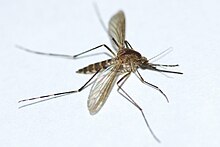
- Aedes explorator Marks, 1964
- Aedes fitchii (Felt and Young, 1904)
- Aedes flavescens (Müller, 1764)
- Aedes flavifrons (Skuse, 1889)
- Aedes fulvus (Wiedemann, 1828)
- Aedes fulvus fulvusWiedemann, 1828
- Aedes fulvus pallensRoss, 1943
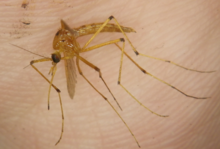
- Aedes grossbecki Dyar and Knab, 1906

- Aedes gutzevichi Dubitzky and Deshevykh, 1978
- Aedes hakusanensis Yamagutiand Tamaboko, 1954
- Aedes harrisoni Muspratt, 1953
- Aedes hastatus Dyar, 1922
- Aedes hesperonotius Marks, 1959
- Aedes hexodontus Dyar, 1916
- Aedes hodgkini Marks, 1959
- Aedes hokkaidensis Tanaka, Mizusawa and Saugstad, 1979
- Aedes hungaricus Mihályi, 1955
- Aedes imperfectus Dobrotworsky, 1962

- Aedes impiger (Walker, 1848)
- Aedes impiger daisetsuzanusTanaka, Mizusawa and Saugstad, 1979
- Aedes impiger impigerWalker, 1848
- Aedes implicatus Vockeroth, 1954
- Aedes incomptus Arnell, 1976
- Aedes increpitus Dyar, 1916

- Aedes inexpectatus BonneWepster, 1948
- Aedes infirmatus Dyar and Knab, 1906
- Aedes intermedius Danilov and Gornostaeva, 1987
- Aedes intrudens Dyar, 1919
- Aedes jacobinae Serafim and Davis, 1933
- Aedes jorgi Carpintero and Leguizamón, 2000
- Aedes juppi McIntosh, 1973
- Aedes kasachstanicus Gutsevich, 1962
- Aedes lasaensis Meng, 1962
- Aedes lasaensis gyirongensis** Ma, 1982
- Aedes lasaensis lasaensisMeng, 1962
- Aedes lepidus Cerqueira and Paraense, 1945
- Aedes leucomelas (Meigen, 1804)
- Aedes linesi Marks, 1964
- Aedes longifilamentus Su and Zhang, 1988
- Aedes luteifemur Edwards, 1926
- Aedes macintoshi Marks, 1959
- Aedes martineti Sevenet, 1937
- Aedes mcdonaldi Belkin, 1962
- Aedes melanimon Dyar, 1924

- Aedes meprai Martínez and Prosen, 1953
- Aedes mercurator Dyar, 1920
- Aedes milleri Dyar, 1922
- Aedes mitchellae (Dyar, 1905)
- Aedes montchadskyi Dubitzky, 1968
- Aedes nevadensis Chapman and Barr, 1964
- Aedes nigrinus (Eckstein, 1918)
- Aedes nigripes (Zetterstedt, 1838)
- Aedes nigrithorax (Macquart, 1847)
- Aedes nigrocanus Martini, 1927
- Aedes nigromaculis (Ludlow, 1906)

- Aedes niphadopsis Dyar and Knab, 1918
- Aedes nivalis Edwards, 1926
- Aedes normanensis (Taylor, 1915)
- Aedes nubilus (Theobald, 1903)
- Aedes obturbator Dyar and Knab, 1907
- Aedes oligopistus Dyar, 1918
- Aedes patersoni Shannon and Del Ponte, 1928
- Aedes pectinatus Arnell, 1976
- Aedes pennai Antunes and Lane, 1938
- Aedes perkinsi Marks, 1949
- Aedes pertinax Grabham, 1906
- Aedes phaecasiatus Marks, 1964
- Aedes phaeonotus Arnell, 1976
- Aedes pionips Dyar, 1919

- Aedes procax (Skuse, 1889)

- Aedes pseudonormanensis Marks, 1949
- Aedes pulcritarsis (Rondani, 1872)
- Aedes pulcritarsis asiaticusEdwards, 1926
- Aedes pulcritarsis pulcritarsisRondani, 1872
- Aedes pullatus (Coquillett, 1904)
- Aedes punctodes Dyar, 1922
- Aedes punctor (Kirby, 1837)

- Aedes purpuraceus Brug, 1932
- Aedes purpureifemur Marks, 1959
- Aedes purpuriventris Edwards, 1926
- Aedes ratcliffei Marks, 1959
- Aedes raymondi Del Ponte, Castro and García, 1951
- Aedes rempeli Vockeroth, 1954
- Aedes rhyacophilus da Costa Lima, 1933
- Aedes riparioides Su and Zhang, 1987
- Aedes riparius Dyar and Knab, 1907

- Aedes sagax (Skuse, 1889)
- Aedes sallumae González and Reyes in González et al., 2017
- Aedes sapiens Marks, 1964
- Aedes scapularis (Rondani, 1848)
- Aedes schizopinax Dyar, 1929
- Aedes schtakelbergi Shingarev, 1928
- Aedes scutellatum Boshell-Manrique, 1939
- Aedes sedaensis Lei, 1989
- Aedes sergievi Danilov, Markovich and Proskuryakova, 1978
- Aedes serratus (Theobald, 1901)
- Aedes shannoni Vargas and Downs, 1950
- Aedes silvestris (Dobrotworsky, 1961)
- Aedes simanini Gutsevich, 1966
- Aedes sinkiangensis Hsiao, 1977
- Aedes sollicitans (Walker, 1856) saltmarsh mosquito
- Aedes spencerii (Theobald, 1901)
- Aedes spencerii idahoensisTheobald, 1903
- Aedes spencerii spenceriiTheobald, 1901
- Aedes spilotus Marks, 1963
- Aedes squamiger (Coquillett, 1902) - California saltmarsh mosquito

- Aedes sticticus (Meigen, 1838) - floodwater mosquito
- Aedes stigmaticus Edwards, 1922
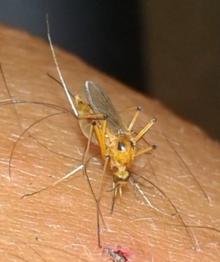
- Aedes stimulans (Walker, 1848) - woodland mosquito
- Aedes stramineus Dubitzky, 1970
- Aedes stricklandi (Edwards, 1912)
- Aedes subalbirostris Klein and Marks, 1960
- Aedes surcoufi (Theobald, 1912)
- Aedes synchytus Arnell, 1976
- Aedes taeniorhynchus (Wiedemann, 1821) - black salt marsh mosquitto
- Aedes tahoensis Dyar, 1916
- Aedes thelcter Dyar, 1918
- Aedes theobaldi (Taylor, 1914)
- Aedes thibaulti Dyar and Knab, 1910
- Aedes tormentor Dyar and Knab, 1906

- Aedes tortilis (Theobald, 1903)
- Aedes trivittatus (Coquillett, 1902)

- Aedes turneri Marks, 1963
- Aedes upatensis Anduze and Hecht, 1943
- Aedes ventrovittis Dyar, 1916
- Aedes vigilax (Skuse, 1889)
- Aedes vigilax ludlowaeBlanchard, 1905
- Aedes vigilax vansomerenaeMattingly in Mattingly and Brown, 1955
- Aedes vigilax vigilax(Skuse, 1889)

- Aedes vittiger (Skuse, 1889)

- Aedes washinoi Lanzaro and Eldridge, 1992

Subgenus (Paraedes) Edwards, 1934
- Aedes barraudi (Edwards, 1934)
- Aedes bonneae Mattingly, 1958
- Aedes chrysoscuta (Theobald, 1910)
- Aedes collessi Mattingly, 1958
- Aedes ostentatio (Leicester, 1908)
- Aedes pagei (Ludlow, 1911)
- Aedes jambulingami (Natarajan, 2019)
- Aedes menoni Mattingly, 1958
- Aedes thailandensis Reinert, 1976
Subgenus (Patmarksia) Reinert, Harbach and Kitching, 2006
- Aedes anggiensis Bonne-Wepster, 1937
- Aedes argenteitarsis Brug, 1932
- Aedes argyronotum Belkin, 1962
- Aedes buxtoni Belkin, 1962
- Aedes clintoni Taylor, 1946
- Aedes derooki Brug, 1932
- Aedes dobodurus King and Hoogstraal, 1946
- Aedes hollandius King and Hoogstraal, 1946
- Aedes mackerrasi Taylor, 1927
- Aedes novalbitarsis King and Hoogstraal, 1946
- Aedes palmarum Edwards, 1924
- Aedes papuensis (Taylor, 1914)
- Aedes subalbitarsis King and Hoogstraal, 1946
Subgenus (Paulianius) Brunhes and Boussés, 2017
- Aedes ambremontis (Brunhes and Boussés, 2017)
- Aedes brucei Wilkerson in Wilkerson, Linton and Strickman, 2020
- Aedes coulangesi (Rodhain and Boutonnier, 1983)
- Aedes grassei (Doucet, 1951)
- Aedes madagascarensis (van Someren, 1949)
- Aedes rhodaini (Brunhes and Boussés, 2017)
- Aedes tiptoni (Grjebine, 1953)
- Aedes zethus (De Meillon and Lavoipierre, 1944)
Subgenus (Petermattinglyius) Reinert, Harbach and Kitching, 2009
- Aedes franciscoi (Mattingly, 1959)
- Aedes iyengari (Edwards, 1923)
- Aedes punctipes (Edwards, 1921)
- Aedes scanloni (Reinert, 1970)
- Aedes whartoni (Mattingly, 1965)
Subgenus (Phagomyia) Theobald, 1905
- Aedes assamensis (Theobald, 1908)
- Aedes cacharanus (Barraud, 1923)
- Aedes cogilli (Edwards, 1922)
- Aedes deccanus (Barraud, 1923)
- Aedes feegradei (Barraud, 1934)
- Aedes gubernatoris (Giles, 1901)
- Aedes gubernatoris gubernatorisGiles, 1901-valid
- Aedes gubernatoris kotiensisBarraud, 1934
- Aedes inquinatus (Edwards, 1922)
- Aedes iwi (Marks, 1955)
- Aedes khazani (Edwards, 1922)
- Aedes kiangsiensis (Tung, 1955)
- Aedes lophoventralis (Theobald, 1910)
- Aedes melanopterus (Giles, 1904)
- Aedes plumiferus (King and Hoogstraal, 1946)
- Aedes prominens (Barraud, 1923)
- Aedes stevensoni (Barraud, 1923)
- Aedes watasei (Yamada, 1921)
Subgenus (Polyleptiomyia) Theobald, 1905
- Aedes albocephalus (Theobald, 1903)
- Aedes gandarai Cunha Ramos, Capela, and Ribeiro 1995)
Subgenus (Protomacleaya) Theobald, 1907
- Aedes aitkeni Schick, 1970
- Aedes alboapicus Schick, 1970
- Aedes amabilis Schick, 1970
- Aedes argyrothorax Bonne-Wepster and Bonne, 1920
- Aedes berlini Schick, 1970
- Aedes bertrami Schick, 1970
- Aedes braziliensis Gordon and Evans, 1922
- Aedes brelandi Zavortink, 1972
- Aedes buenaventura Schick, 1970
- Aedes burgeri Zavortink, 1972
- Aedes campana Schick, 1970
- Aedes casali Schick, 1970
- Aedes chionotum Zavortink, 1972
- Aedes daryi Schick, 1970
- Aedes diazi Schick, 1970
- Aedes gabriel Schick, 1970
- Aedes galindoi Schick, 1970
- Aedes hendersoni Cockerell, 1918

- Aedes heteropus Dyar, 1921
- Aedes homoeopus Dyar, 1922
- Aedes idanus Schick, 1970
- Aedes impostor Schick, 1970
- Aedes insolitus (Coquillett, 1906)
- Aedes knabi (Coquillett, 1906)
- Aedes kompi Vargas and Downs, 1950
- Aedes lewnielseni Ortega and Zavortink, 2019
- Aedes metoecapus Dyar, 1925
- Aedes niveoscutum Zavortink, 1972
- Aedes podographicus Dyar and Knab, 1906
- Aedes sandrae Zavortink, 1972
- Aedes schicki Zavortink, 1972
- Aedes schroederi Schick, 1970
- Aedes sumidero Schick, 1970
- Aedes tehuantepec Schick, 1970
- Aedes terrens (Walker, 1856)
- Aedes thorntoni Dyar and Knab, 1907
- Aedes triseriatus (Say, 1823) (Eastern Treehole Mosquito)
- Aedes vargasi Schick, 1970
- Aedes zavortinki Schick, 1970
- Aedes zoosophus Dyar and Knab, 1918
Subgenus (Pseudalbuginosus) Huang and Rueda, 2015
- Aedes grjebinei Hamon, Taufflieb and Maillot, 1957
Subgenus (Pseudarmigeres) Stone and Knight, 1956
- Aedes albomarginatus (Newstead, 1907)
- Aedes argenteoventralis (Theobald, 1909)
- Aedes argenteoventralis argenteoventralis(Theobald, 1909)
- Aedes argenteoventralis dunni(Evans, 1928)
- Aedes kummi Edwards, 1930
- Aedes michaelikati van Someren, 1946
- Aedes michaelikati gurnerivan Someren, 1946
- Aedes michaelikati michaelikativan Someren, 1946
- Aedes natalensis Edwards, 1930
Subgenus (Pseudoskusea) Theobald, 1907
- Aedes bancroftianus Edwards, 1921
- Aedes culiciformis (Theobald, 1905)
- Aedes multiplex (Theobald, 1903)
- Aedes postpiraculosus Dobrotworsky, 1961
Subgenus (Rampamyia) Reinert, Harbach and Kitching, 2006
- Aedes albilabris Edwards, 1925
- Aedes notoscriptus (Skuse, 1889)
- Aedes notoscriptus montanaBrug, 1939
- Aedes notoscriptus notoscriptusSkuse, 1889
- Aedes quinquelineatus Edwards, 1922
Subgenus (Reinertia) Somboon, Namgay and Harbach in Somboon, Phanitchakun, Saingamsook, Namgay and Harbach, 2021
- Aedes suffusus Edwards, 1922
Subgenus (Rhinoskusea) Edwards, 1929
- Aedes longirostris (Leicester, 1908)
- Aedes pillaii Mattingly, 1958
- Aedes portonovoensis Tewari and Hiriyan, 1992
- Aedes wardi Reinert, 1976
Subgenus (Rusticoidus) Shevchenko and Prudkina, 1973
- Aedes albescens Edwards, 1921
- Aedes bicristatus Thurman and Winkler, 1950
- Aedes krymmontanus Alekseev, 1989
- Aedes lepidonotus Edwards, 1920
- Aedes provocans (Walker, 1848)
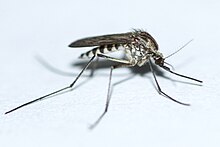
- Aedes quasirusticus Torres Cañamares, 1951
- Aedes refiki Medschid, 1928
- Aedes rusticus (Rossi, 1790)
- Aedes rusticus rusticusRossi, 1790
- Aedes rusticus subtrichurusMartini, 1927
- Aedes subdiversus Martini, 1926
Subgenus (Sallumia) Reinert, Harbach and Kitching, 2008
- Aedes hortator Dyar and Knab, 1907
- Aedes perventor Cerqueira and Costa, 1946
Subgenus (Scutomyia) Theobald, 1904
- Aedes albolineatus (Theobald, 1904)
- Aedes arboricolus Knight and Rozeboom, 1946
- Aedes bambusicolus Knight and Rozeboom, 1946
- Aedes boharti Knight and Rozeboom, 1946
- Aedes hoogstraali Knight and Rozeboom, 1946
- Aedes impatibilis (Walker, 1859)
- Aedes laffooni Knight and Rozeboom, 1946
- Aedes platylepidus Knight and Hull, 1951
- Aedes pseudoalbolineatus Brug, 1939
Subgenus (Skusea) Theobald, 1903
- Aedes cartroni Ventrillon, 1906
- Aedes lambrechti van Someren, 1971
- Aedes moucheti Ravaonjanahary and Brunhes, 1977
- Aedes pembaensis Theobald, 1901
Subgenus (Stegomyia) Theobald, 1901
- Aedes aegypti (Linnaeus, 1762) - yellow fever mosquito,
- Aedes aegypti aegypti(Linnaeus, 1762)
- Aedes aegypti formosus(Walker, 1848)
- Aedes africanus (Theobald, 1901) yellow fever mosquito
- Aedes agrihanensis Bohart, 1957
- Aedes albopictus Skuse, 1895 - forest day mosquito, Asian tiger mosquito, tiger mosquito
- Aedes alcasidi Huang, 1972
- Aedes alorensis Bonne-Wepster and Brug, 1932
- Aedes amaltheus De Meillon and Lavoipierre, 1944
- Aedes andrewsi Edwards, 1926
- Aedes angustus Edwards, 1935
- Aedes annandalei (Theobald, 1910)
- Aedes annandalei annandalei(Theobald, 1910)
- Aedes annandalei quadricinctusBarraud, 1923
- Aedes aobae Belkin, 1962
- Aedes apicoargenteus (Theobald, 1909)
- Aedes bambusae Edwards, 1935
- Aedes blacklocki Evans, 1925
- Aedes bromeliae (Theobald, 1911)
- Aedes burnsi Basio and Reisen, 1971
- Aedes calceatus Edwards, 1924
- Aedes chaussieri Edwards, 1923
- Aedes chemulpoensis Yamada, 1921
- Aedes contiguus Edwards, 1936
- Aedes cooki Belkin, 1962
- Aedes corneti Huang, 1986
- Aedes craggi ( Barraud, 1923)
- Aedes cretinus Edwards, 1921

- Aedes daitensis Miyagi and Toma, 1981
- Aedes deboeri Edwards, 1926
- Aedes demeilloni Edwards, 1936
- Aedes denderensis Wolfs, 1949
- Aedes dendrophilus Edwards, 1921
- Aedes desmotes (Giles, 1904)
- Aedes dybasi Bohart, 1957
- Aedes ealaensis Huang, 2004
- Aedes edwardsi ( Barraud, 1923)
- Aedes ethiopiensis Huang, 2004
- Aedes flavopictus Yamada, 1921
- Aedes flavopictus flavopictusYamada, 1921
- Aedes flavopictus miyaraiTanaka, Mizusawa and Saugstad, 1979
- Aedes fraseri (Edwards, 1912)
- Aedes futunae Belkin, 1962
- Aedes gallois Yamada, 1921
- Aedes galloisiodes Liu and Lu, 1984
- Aedes gandaensis Huang, 2004
- Aedes gardnerii (Ludlow, 1905)
- Aedes gardnerii gardneriiLudlow, 1905
- Aedes gardnerii imitatorLeicester, 1908
- Aedes grantii (Theobald, 1901)
- Aedes guamensis Farner and Bohart, 1944
- Aedes gurneyi Stone and Bohart, 1944
- Aedes hakanssoni Knight and Hurlbut, 1949
- Aedes hansfordi Huang, 1997
- Aedes hebrideus Edwards, 1926
- Aedes heischi van Someren, 1951
- Aedes hensilli Farner, 1945
- Aedes hogsbackensis Huang, 2004
- Aedes hoguei Belkin, 1962
- Aedes horrescens Edwards, 1935
- Aedes josiahae Huang, 1988
- Aedes katherinensis Woodhill, 1949
- Aedes keniensis van Someren, 1946
- Aedes kenyae van Someren, 1946
- Aedes kesseli Huang and Hitchcock, 1980
- Aedes kivuensis Edwards, 1941
- Aedes krombeini Huang, 1975
- Aedes langata van Someren, 1946
- Aedes ledgeri Huang, 1981
- Aedes lilii (Theobald, 1910)
- Aedes luteocephalus (Newstead,1907)
- Aedes maehleri Bohart, 1957
- Aedes malayensis Colless, 1962
- Aedes malikuli Huang, 1973
- Aedes marshallensis Stone and Bohart, 1944
- Aedes mascarensis MacGregor, 1924
- Aedes masseyi Edwards, 1923
- Aedes matinglyorum
- Aedes maxgermaini Huang, 1990
- Aedes mediopunctatus (Theobald, 1905)
- Aedes mediopunctatus mediopunctatusTheobald, 1905
- Aedes mediopunctatus sureilensisBarraud, 1934
- Aedes metallicus ( Edwards, 1912)
- Aedes mickevichae Huang, 1988
- Aedes mpusiensis Huang, 2004
- Aedes muroafcete Huang, 1997
- Aedes neoafricanus Cornet, Valade and Dieng, 1978
- Aedes neogalloisi Chen and H B Chen, 2000
- Aedes neopandani Bohart, 1957
- Aedes njombiensis Huang, 1997
- Aedes novalbopictus Barraud, 1931
- Aedes opok Corbet and van Someren, 1962
- Aedes palauensis Bohart, 1957
- Aedes pandani Stone, 1939
- Aedes patriciae Mattingly, 1954
- Aedes paullusi Stone and Farner, 1945
- Aedes pernotatus Farner and Bohart, 1944
- Aedes perplexus (Leicester, 1908)
- Aedes pia (Le Goff and Robert in Le Goff et al, 2013)
- Aedes polynesiensis Marks, 1951
- Aedes poweri (Theobald, 1905)

- Aedes pseudoafricanus Chwatt, 1949
- Aedes pseudoalbopictus (Borel, 1928)
- Aedes pseudonigeria (Theobald, 1910)
- Aedes pseudoscutellaris (Theobald, 1910)
- Aedes quasiscutellaris Farner and Bohart, 1944
- Aedes rhungkiangensis P-X Chang and S M Chang, 1974
- Aedes riversi Bohart and Ingram, 1946
- Aedes robinsoni Belkin, 1962
- Aedes rotanus Bohart and Ingram, 1946
- Aedes rotumae Belkin, 1962
- Aedes ruwenzori Haddow and van Someren, 1950
- Aedes saimedres Huang, 1988
- Aedes saipanensis Stone, 1945
- Aedes sampi Huang, 2004
- Aedes schwetzi Edwards, 1926
- Aedes scutellaris (Walker, 1859)
- Aedes scutoscriptus Bohart and Ingram, 1946
- Aedes seampi Huang, 1974
- Aedes seatoi Huang, 1969
- Aedes segermanae Huang, 1997
- Aedes sibiricus Danilov and Filippova, 1978
- Aedes simpsoni (Theobald, 1905)
- Aedes soleatus Edwards, 1924
- Aedes strelitziae Muspratt, 1950
- Aedes subalbopictus Barraud, 1931
- Aedes subargenteus Edwards, 1925
- Aedes tabu Ramalingam and Belkin, 1965
- Aedes tongae Edwards, 1926
- Aedes tulagiensis Edwards, 1926
- Aedes unilineatus (Theobald, 1906)
- Aedes upolensis Marks, 1957
- Aedes usambara Mattingly, 1953
- Aedes varuae Belkin, 1962
- Aedes vinsoni Mattingly, 1953
- Aedes w-albus (Theobald, 1905)
- Aedes wadai Tanaka, Mizusawa and Saugstad, 1979
- Aedes woodi Edwards, 1922
Subgenus (Tanakaius) Reinert, Harbach and Kitching, 2004
- Aedes savoryi Bohart, 1957
- Aedes togoi Theobald, 1907

Subgenus (Tewarius) Reinert, 2006
- Aedes agastyai Tewari and Hiriyan, 1992
- Aedes nummatus Edwards, 1923
- Aedes pseudonummatus Reinert, 1973
- Aedes reubenae Tewari and Hiriyan, 1992
Subgenus (Vansomerenis) Reinert, Harbach and Kitching, 2006
- Aedes hancocki van Someren, 1962
- Aedes luteostriatus Robinson, 1950
- Aedes pulchrithorax Edwards, 1939
Subgenus (Zavortinkius) Reinert, 1999
- Aedes brunhesi Reinert, 1999
- Aedes brygooi Brunhes, 1971
- Aedes fulgens (Edwards, 1917)
- Aedes geoffroyi Reinert, 1999
- Aedes huangae Reinert, 1999
- Aedes interruptus Reinert, 1999
- Aedes longipalpis (Grünberg, 1905)
- Aedes monetus Edwards, 1935
- Aedes mzooi van Someren, 1962
- Aedes phillipi van Someren, 1949
- Aedes pollinctor (Graham, 1910)
